Understanding Water Needs in Beef Cattle Management
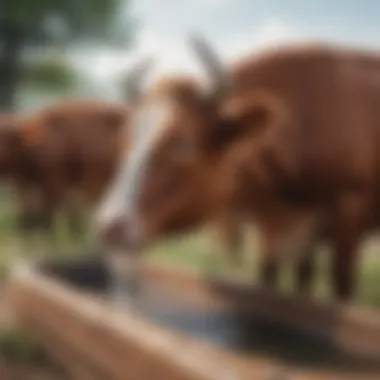
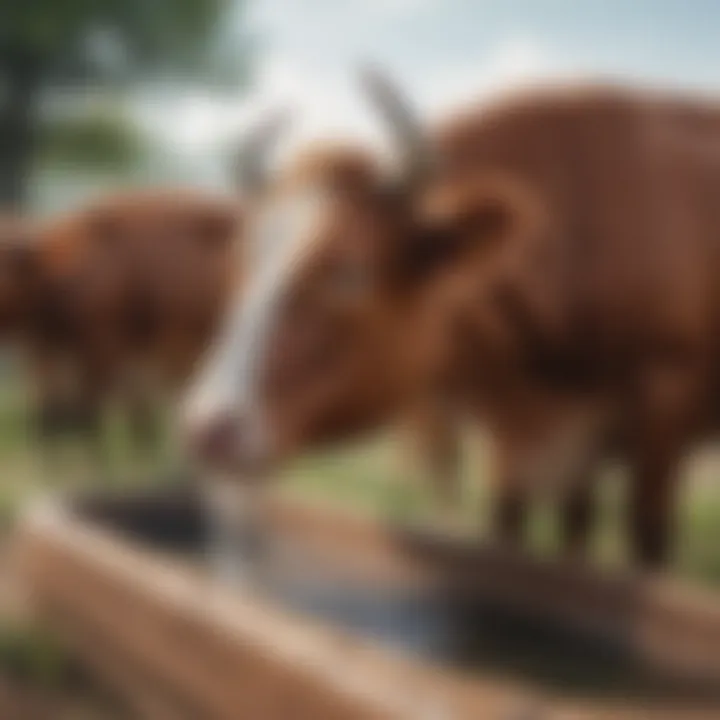
Intro
Navigating the waters of cattle management often hinges on one essential factor: water. Beef cattle, central to livestock production, require a consistent and adequate supply of water to maintain health and productivity. The intricacies of their water consumption can be influenced by a multitude of variables, from environmental conditions to dietary composition. This article intends to shed light on the daily water requirements of beef cows, illustrating the significance of proper hydration in effective cattle management.
Beef cattle are large mammals, known for their robust bodies and strong musculature. Understanding their behavior, physiology, and needs can enhance the management practices that ensure their welfare and productivity.
In the following sections, we will explore:
- The characteristics of beef cattle and their natural habitat.
- Key factors affecting water consumption, such as temperature and humidity.
- The nutritional role of water in the cattle diet.
By delving deep into these aspects, we aim to provide insightful knowledge for those involved in animal husbandry, whether they are seasoned farmers or newcomers to the field.
Prologue to Beef Cow Hydration
Understanding how much water beef cattle need is a crucial segment in livestock management. Water, often overlooked, plays several roles beyond just quenching thirst. It supports basic physiological functions, aids digestion, and impacts overall health and productivity. As such, grasping the nuances of beef cow hydration not only benefits the cattle but also has significant implications for farmers looking to enhance their operation’s efficiency and sustainability.
Importance of Water in Bovine Health
Water is not merely a liquid; it is a lifeline for beef cattle. Cows, being large animals, can consume a substantial amount of water daily. Lack of adequate hydration can lead to serious health issues, including dehydration, which is often indicated by poor feed conversion, lowered milk production in lactating cows, and even increased disease susceptibility.
- Physiological Functions: Water serves in various physiological roles—regulating body temperature, helping nutrient absorption, and facilitating metabolic processes. A well-hydrated cow is more likely to have improved digestion and absorption of feed nutrients, significantly contributing to weight gain and overall productivity.
- Health Implications: Dehydrated cattle show behavioral changes like lethargy and decreased social interaction. Furthermore, chronic dehydration can lead to complications like kidney stones and serious metabolic disorders, making it imperative for cattle farmers to monitor their herd's water intake diligently.
Overview of Beef Cattle Farming
The complexity of beef cattle farming lies not just in managing the animals themselves but encapsulating various factors like genetics, nutrition, and yes, water consumption. Effective livestock management necessitates a deep dive into how water needs align with beef production goals.
- Farming Practices: Beef cattle farming techniques vary widely based on geographical regions, herd size, and market demands. The core aim remains the same – ensuring cattle are healthy and productive.
- Water Supply Strategies: To maintain optimal hydration, farmers must consider the source, quality, and accessibility of water on their farms. For instance, some ranchers might utilize streams or troughs, while others could invest in advanced water management systems.
- Nutritional Context: It's also vital to contemplate how the diet might influence water needs. For example, cattle consuming dry feeds might require higher water intake compared to those fed lush grasses, making it essential to tailor hydration strategies according to dietary habits.
Factors Influencing Daily Water Intake
Understanding the various factors that affect the daily water intake of beef cattle is paramount for ensuring their health and productivity. Cows, being large and complex animals, have particular needs when it comes to hydration, and several elements can influence how much water they consume each day. This article examines three main reasons:
- Nutritional health: Adequate water intake is closely linked with nutrient absorption and overall health in cattle.
- Farming efficiency: By recognizing what influences water consumption, farmers can better manage their livestock, potentially improving weight gain and milk production.
- Environmental adaptation: Cattle are subject to various external factors that may affect their drinking habits, making it essential to understand these influences.
Body Weight and Size
The body weight and size of beef cattle have a direct impact on how much water they need. Generally, heavier animals require more water, as their larger body mass demands greater hydration to maintain physiological functions. As a rule of thumb, cattle should drink about one gallon for every hundred pounds of body weight.
In practical terms, this means that a 1,200-pound cow may need around 12 gallons of water per day. Beyond just weight, the overall size, including body surface area, plays a role in determining water requirements. Larger breeds naturally have higher water needs due to their size. This simple yet essential equation allows farmers to estimate water needs based on the breeds they raise.
Diet Composition
The composition of a cow's diet also significantly affects daily water intake. For instance, a ration high in dry feed, like hay or silage, necessitates increased water consumption compared to lush, green pasture, which contains higher moisture levels. When beef cattle are fed dry feedstuff, they often need 2 to 5 gallons more water each day than if they were grazing on green pastures.


Understanding these dietary interactions can help in planning and providing adequate hydration. As cattle owners, being aware of ingredients and how they can alter water needs is of absolute importance to maintain optimal animal welfare.
Environmental Conditions
Environmental factors encompass temperature, humidity, and seasonal variations, all of which can greatly influence cattle's water consumption.
Temperature Effects
When temperatures soar, beef cattle tend to drink more water to cool down—this prevents heat stress, common in hot months. Cattle’s water intake will typically increase by 1 to 2 gallons for each degree above 70°F. It's essential to ensure access to ample water in such conditions, as excessive heat can lead to increased respiration rates, digestive issues, and reduced feed intake. On the flip side, in cold weather, cows might drink less, yet they still require sufficient hydration for digestion and maintaining metabolic functions.
Humidity Levels
Humidity plays a vital role as well. In high-humidity environments, even with warm temperatures, cattle may drink less because the moist air helps them cool off. However, low humidity combined with high temperatures can exacerbate heat stress, leading to increased water consumption. Recognizing these intricacies can help farmers provide adequate water supplies, ensuring their cattle remain hydrated and healthy irrespective of the weather conditions.
Seasonal Variability
Cattle water needs can shift dramatically with the seasons. During summer, with heat and increased feed consumption, the demand for water usually peaks. Conversely, winter months may see a decline in liquid intake as feed moisture levels may be higher in stored forages. Understanding these shifts can aid in better planning for hydration needs. This flexibility ensures that regardless of time of year, beef cattle maintain their hydration and, consequently, their health.
"Monitoring your herd's water intake can reveal much about their health and welfare."
Estimated Water Requirements
Understanding the estimated water requirements of beef cattle is crucial not only for their health but also for optimizing production. Water is a fundamental element in the life of these animals; it plays a significant role in digestion, thermoregulation, and overall metabolic functioning. When farmers grasp these water needs, they can make informed decisions that enhance productivity and animal welfare.
Standard Daily Intake Figures
General Guidelines
When discussing general guidelines for daily water intake, the common estimates suggest that an adult beef cow generally requires between 8 and 12 gallons of water per day. This average hinges on several factors, which include the cow's weight, diet, and environmental conditions. A key characteristic of these guidelines is that they provide a broad framework, helping farmers gauge how much water their herds may need under typical circumstances.
The unique feature here is that while these figures serve as a baseline, they may vary. For example, if the diet is high in dry matter—think of straw or hay—cattle will drink significantly more. This fact underpins the importance of regularly monitoring cattle hydration, especially post-feeding. Optimal hydration leads to better feed efficiency and weight gain, making it a beneficial focal point in beef cattle management.
Variations by Age and Growth Stage
Age and growth stage introduce significant variations in water intake. Younger calves, for instance, typically consume less water compared to mature cows, often ranging anywhere from 2 to 5 gallons per day. Importantly, as cattle grow, their water needs increase dramatically—this is a key aspect when one considers growth patterns from weaning to adulthood.
One must highlight that this variation by age and growth stage is more than just a number; it holds vital implications for herd management strategies. Younger animals have different hydration demands that must be met to ensure proper growth and avoid health complications. Therefore, understanding these requirements allows for tailored care practices that can boost livestock development.
Water Intake during Lactation
Lactating cows have significantly higher water intake needs, which can leap to 15 or even 20 gallons a day. This increase correlates directly with the demands of milk production. During lactation, the supply of water directly affects the quality and quantity of milk produced, emphasizing the importance of ensuring ample water availability during this stage.
Farmers should be diligent in observing water consumption patterns, especially in nursing cows. Insufficient water can lead to reduced milk yield and even impact calf growth rates, bringing forth implications for economic viability. This key factor underlines the necessity to create strategies surrounding water access during lactation, ensuring that both mother and calf remain healthy and thriving.
"Water is not just a resource, it’s the lifeblood of successful cattle management."
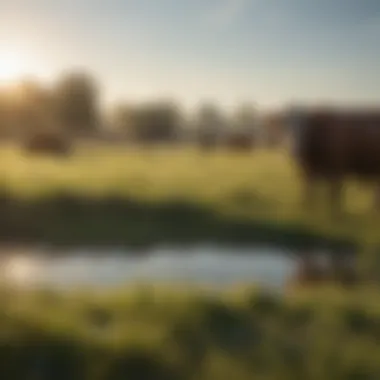
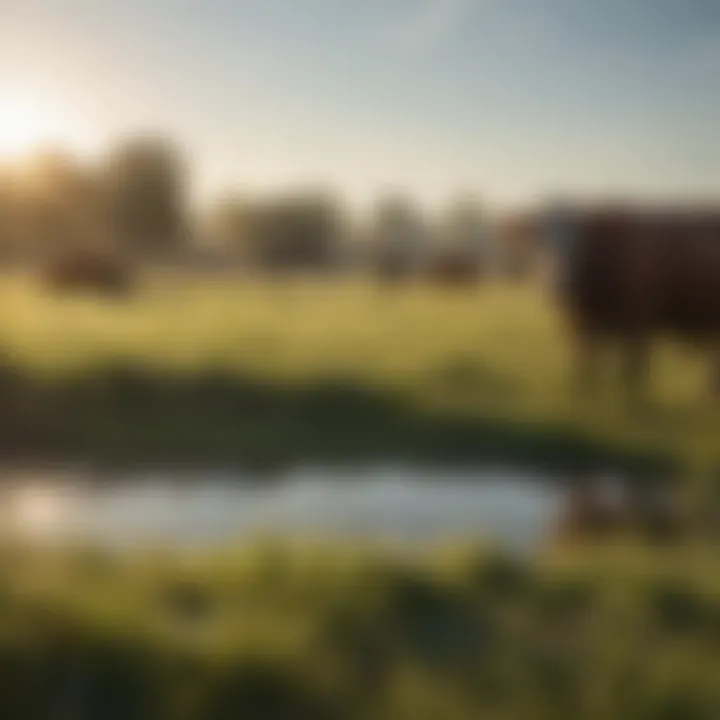
In essence, estimating water requirements in beef cattle illustrates how interconnected hydration is with overall health, growth, and productivity in livestock. By adequately addressing these needs, farmers can not only enhance animal welfare but also improve the efficiency and profitability of their operations.
Monitoring Water Consumption
Monitoring water consumption in beef cattle is a critical aspect that cannot be overlooked. Each bovine's well-being, productivity, and overall health hinge on adequate hydration. Knowing how much water a cow drinks allows farmers to anticipate and address any potential issues before they escalate into costly problems. Effective monitoring can lead to improved feed efficiency, reduced veterinary expenses, and enhanced weight gains. Furthermore, paying attention to water intake helps in adjusting the management practices to meet the specific needs of the cattle based on external conditions.
Techniques for Accurate Measurement
Accurate measurement of water intake can be achieved through various methods. Traditional methods like measuring the amount of water put out in troughs against what is left can give a rough estimate. However, this often lacks precision. High-tech options now exist, including the use of flow meters which can be installed in watering systems. These devices record the exact amount of water consumed by the cattle, providing data that is both accurate and easy to analyze.
Moreover, automatic watering systems can track water usage on an individual basis. Another practical approach is to observe animals during specific times of the day, which can reveal patterns, such as increased intake when the animals are grazing or during hot conditions.
Understanding these techniques is essential for maintaining optimal water intake.
Identifying Dehydration Signs
Recognizing when cattle are dehydrated is vital for effective management. The signs can be subtle and may vary between individuals.
Behavioral Indicators
When observing behavioral indicators, pay special attention to changes in normal activities. Cattle that are not drinking adequate water may show signs of lethargy or listlessness. They could move less, segregating from the herd, which indicates unwellness. One notable behavioral characteristic is a decrease in cud chewing; this usually means something is wrong. Recognizing this subtlety is crucial for prompt action. Understanding these behaviors can help managers take preemptive steps to provide access or identify any underlying issues.
Physical Signs
In addition to behavioral cues, physical signs are also key indicators of dehydration. The most prominent sign is skin elasticity; if the skin does not return promptly after being pulled, this requires attention. Other physical attributes to observe include sunken eyes or dry mucous membranes, which indicate deficiencies in fluid levels. Another notable physical characteristic is the temperature of the animal's body; a higher-than-normal temperature can also signify hydration problems. Recognizing these signs can greatly improve the management and care of the cattle.
Keeping a close watch on both behavioral and physical signs of dehydration can avert severe health complications and loss in productivity.
By staying proactive in monitoring water consumption and recognizing signs of dehydration, cattle farmers can enhance livestock health and ultimately lead to more efficient operations.
Implications for Cattle Management
The management of beef cattle hinges significantly on their water consumption. Understanding the implications this has can influence productivity, animal health, and ultimately the sustainability of ranching operations. The amount of water cattle consume directly affects their growth rates, milk production, and feed conversion efficiency. Thus, ensuring that cattle have adequate and clean water is not merely a matter of maintaining hydration. It’s a fundamental component that underpins the entire management philosophy in beef production. By strategically addressing water supply issues, ranchers can enhance overall herd performance and reduce costs associated with health issues stemming from dehydration.
Optimizing Water Supply
Watering Systems
Watering systems are essential components of cattle management. These systems, whether they are troughs, tanks, or automatic waterers, must be designed with efficiency and ease of access in mind. A well-designed watering system allows for a consistent supply of water, promoting better hydration among the cattle. This is crucial because it directly correlates with their health and productivity levels. A key characteristic of modern watering systems is the incorporation of float valves, which minimize overflow and wastage. This not only conserves water but also ensures a clean water supply. The advantage is clear; a reliable watering system contributes greatly to the overall well-being of the herd, while a poorly maintained system can lead to health problems, such as urinary tract infections. In some regions, solar-powered watering solutions have made a name for themselves, providing an eco-friendly alternative that cuts costs over time.
Quality Considerations
Quality considerations go hand in hand with optimizing water supply. The quality of water that cattle consume is vitally important. Clean, potable water is essential for preventing disease and ensuring optimal growth rates. Contaminated water can lead to a range of health issues, including diarrhea and pneumonia, both of which can be costly for a farm operation. A system that ensures regular checks on water quality is critical. This can include routine testing for contaminants and regular maintenance of water infrastructure. The unique feature of focusing on water quality is its long-term benefits; premium quality water can boost cattle's immune systems, leading to reduced veterinary costs. Thus, ranchers benefit from investing in quality systems that monitor and ensure the cleanliness of water.
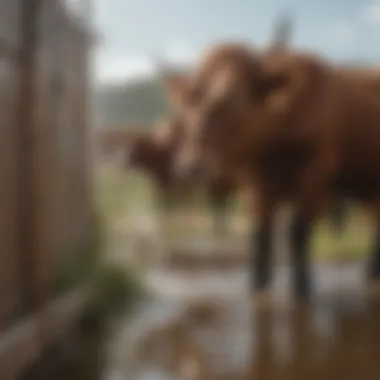
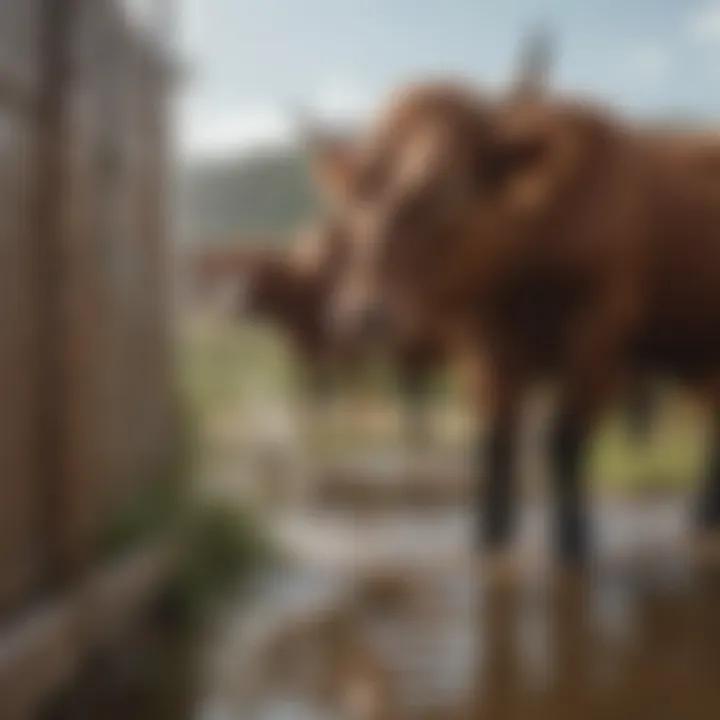
Impact on Feed Efficiency
Water consumption has a direct impact on feed efficiency. If a cattle doesn’t have access to sufficient water, it may lead to decreased feed intake. When cattle are poorly hydrated, they tend to consume less feed, which can stunt their growth and affect overall productivity. Additionally, adequate water aids in digestion and nutrient absorption, making it a crucial component in converting feed into energy effectively. Conversely, if cattle are well-hydrated, they generally exhibit better health, leading to improved feed conversion ratios. Higher efficiency means more meat produced per unit of feed consumed, which is a fundamental goal in beef production. Overall, managing water supply and assuring its quality influences not just the immediate health of the cattle but also the economics of beef production.
Regional Variations in Water Needs
Climate-Dependent Consumption Patterns
Cows, much like a well-timed clock, adjust their water intake based on the surrounding climate. It’s fascinating how much temperature can sway their drinking habits. For instance, in hotter climates, such as parts of Texas or southern Australia, cows may require upwards of 20-30% more water than those in cooler regions.
- High Temperature Impacts: When temperatures soar, cows can easily become dehydrated if not given enough water. They might exhibit signs of stress, impacting their productivity.
- Seasonal Considerations: During the summer months, higher evaporation rates can diminish water sources. Therefore, it’s important to monitor how much water is available to cattle during this time and adjust as needed.
- Consistency in Availability: Ensuring that a steady supply of water is available at all times can help alleviate some of the consumption pressures brought on by extreme temperatures.
From a farmer's perspective, adapting to these climatic variations means planning ahead. If rising temperatures are on the horizon, increasing water access through additional troughs or more sophisticated watering systems becomes a necessity.
Geographical Influence on Farming Practices
The lay of the land plays just as significant a role as climate does in dictating how much water cattle require. Vast, sprawling pastures in the Midwest USA may offer different water procurement strategies compared to smaller, intensive farming settings found in New England. The geographical context shapes everything from land use to how farmers manage water resources.
- Topography: In hilly regions, water can easily run off, creating scarcity in some areas while pooling in others. Cattle may need to travel further in search of hydration, impacting their daily routines.
- Soil Types: Softer soils can retain more moisture, which indirectly influences the quality of the forage available. Areas with sandy soils may require more water supplementation for cattle to thrive, as these soils drain quickly.
- Local Water Sources: Farmers must consider the proximity and quality of local water sources, from lakes and rivers to wells. Access to clean, reliable water is paramount—not just for cattle consumption but also for maintaining their overall health.
"Effective water management can significantly enhance the overall productivity of beef operations. Understanding the local climate and geography helps in making informed decisions."
In summary, recognizing these regional differences in water needs is essential. It allows for informed decision-making and proactive management techniques, ensuring that cattle stay healthy and productive no matter where they are raised.
By keeping an eye on environmental factors and adjusting practices accordingly, cattle owners can better navigate the nuances of water consumption in beef cattle and improve both animal welfare and farming outcomes.
Research and Future Directions
Exploring research and future directions in water consumption for beef cattle sheds light on how scientists, ranchers, and veterinary professionals strive to enhance not only cattle wellbeing but also production efficiencies. Hydration is pivotal in ensuring optimal growth, reproduction, and overall health of beef cattle, which invariably leads to increased productivity. By investigating same, we can uncover new insights that can be potentially transformative within the beef industry.
One important aspect is the ongoing clinical and field studies that seek to determine the exact water needs of different breeds and their responses to varying environmental conditions. These findings can help farmers better tailor their management strategies to ensure that all cattle are getting adequate hydration throughout their lifecycle. With the climate crisis looming, the adaptability of cattle to extreme weather patterns offers fertile ground for research. By understanding responses to heat stress, ranchers could employ practices that not only protect animal welfare but also safeguard their economic interests.
"Water is the lifeblood of our cattle ranching enterprise; understanding it helps us thrive"
— Anonymous Rancher
Current Studies on Water and Beef Cattle
Current studies reveal a wealth of knowledge that is enriching the understanding of bovine hydration. Researchers are increasingly focused on how age, weight, and breeds influence water consumption patterns. For instance, recent investigations underscore the differences in water intake between weaning calves and fully grown cows. Young cattle may require less water due to their size, but as they grow, their intake needs can increase substantially to support their development and physiological demands.
Moreover, studies look into the effects of dietary components on water intake. For example, higher fiber diets may necessitate greater water consumption for digestion, leading to adjustments in management protocols. Here are a few notable observations from recent research:
- Nutritional Factors: Diets rich in dry matter typically increase water intake needs.
- Age-Related Requirements: Younger cattle have different hydration benchmarks compared to adults.
- Ranch Management Practices: Innovative strategies can lead to more efficient water usage.
Understanding these nuanced details is paramount for optimizing herd health and operational efficiency.
Emerging Technologies in Water Management
As technology continues to develop, the methods for managing water consumption in beef cattle are becoming smarter and more effective. Technological advancements pave the way for precision agriculture, enabling farmers to measure water intake with greater accuracy. Here are some promising developments in the sphere of water management:
- Smart Waterers: Modern watering systems equipped with sensors track individual animal water consumption, providing data for better management decisions.
- Remote Monitoring: Utilizing IoT (Internet of Things), ranchers can monitor hydration levels and detect any anomalies in real-time.
- Water Quality Sensors: Technologies that analyze water quality can alert managers to contaminants that might affect cattle health, ensuring high standards are met.
These emerging technologies not only enhance cattle care but also promote sustainability in beef farming, making it a win-win situation for all involved in the livestock sector.







